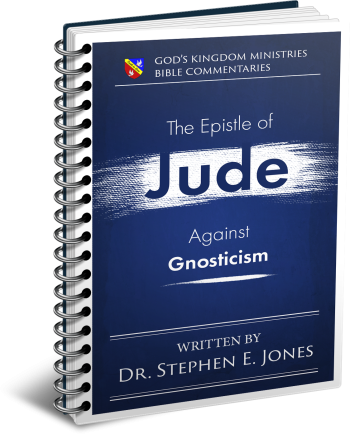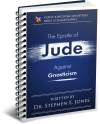Latest Posts
View the latest posts in an easy-to-read list format, with filtering options.

Jesus' brother, Jude, wrote a letter to the Jewish Christian congregations in the first century, warning them about Gnosticism and also urging them to stand firm in faith against their Jewish critics.
Category - Bible Commentaries

Jude’s fourth analogy is found in Jude 13, which says,
13 wild waves of the sea, casting up their own shame like foam; wandering stars, for whom the black darkness has been reserved forever [eis aiona, “for an age”].
Here Jude compares the Gnostics with “wild waves of the sea,” because waves leave foam and debris along the shoreline, even as the Gnostics expose “their own shame.” The word shame is used in the Hebraic sense, not only of being ashamed but, by implication, one’s “shame” refers to one’s idol. The Hebrew word is bosheth.
An example of this is found in Jer. 3:24, “But the shameful thing has consumed the labor of our fathers since our youth.” Again, we read in Hosea 9:10, “But they came to Baal-peor and devoted themselves to shame.”
As Jude was of Judah and was writing primarily to his fellow countrymen, his audience would have understood the implication of bosheth. Jude was telling them that the Gnostics were not true followers of Christ but were worshiping other gods in the guise of worshiping the God of Israel. In Jer. 2:28 the prophet asks,
28 But where are your gods which you made for yourself? Let them arise if they can save you in the time of your trouble; for according to the number of your cities are your gods, O Judah.
The prophet denounced this pretense, but the people themselves appeared to be blind to what they were doing. In Jer. 2:35 the prophet gives the people’s response to charges of idolatry, saying,
35 Yet you said, “I am innocent; surely His anger is turned away from me.” Behold, I will enter into judgment with you because you say, “I have not sinned.”
The purpose of Jude’s epistle was largely the same as Jeremiah’s writing in this way. Both of them saw the problem, but there were many in their audiences that were blind to it. In fact, such is the nature of idolatry, for men do not recognize idols in their hearts until they are overthrown.
The final analogy that Jude uses compares the Gnostic teachers to “wandering stars, for whom the black darkness has been reserved for ever” (i.e., “for the age,” as The Emphatic Diaglott correctly reads).
In the terminology of the day, there were “fixed stars” and “wandering stars” in the heavens. The wandering stars were called by the Greek term, astares planetai. They are the planets, which appear to move in the heavens. In those days the moon and sun were considered to be the closest planets, followed by five (actual) planets: Mercury, Venus, Mars, Jupiter, and Saturn. These formed the theology of the mystery religions in those days.
It is evident that Jude gave no religious credence to the planets. His analogy suggests the Gnostic view involved pointless meandering (speculations and mythology) that went nowhere.
Gnosticism, however, had found fertile ground in Egypt, giving rise to the so-called Gnostic Gospels of that era. Many of them were discovered by archeologists in 1945.
That is why and how the Gnostic gospels were created. The Gnostics fraudulently attached the names of famous Christians to their writings, such as the gospel of Thomas, the gospel of Philip, the gospel of Mary, etc. The discovery of the Nag Hammadi library in southern Egypt in 1945 represented a major discovery of Gnostic gospels. These Gnostic gospels are often pointed to as supposed “lost books of the Bible.”
https://www.gotquestions.org/Gnostic-gospels.html
These Gnostic Gospels were never accepted outside of Gnostic circles. It was a common literary tactic in those days to write under a pseudonym. In order to give books more credence, men often attributed their writing to a more famous dead man who could not object to his name being so misused. This tactic was well known to the early Church, and for this reason they were more discriminatory than many Christians are today. For good reason the Gnostic Gospels were excluded from the canon of the New Testament.
In my view, the Apostle John was charged with formalizing the canon, as I explained in chapters 23 and 24 of my book, Lessons from Church History, Vol. 1. Before Paul died, he charged Timothy with the responsibility of delivering selected epistles to John for inclusion in the canon. John’s mission was complete only after finishing the book of Revelation in 96 A.D., just before his death in the year 100.
In later years the Church Councils examined the evidence and formalized the canon that had already been adopted and used by the majority of the early Church. There are no “lost gospels” as such. There are some letters that Paul did not see fit to include in the canon, of course, such as a third letter to the Corinthians. There were also many other writings in the early Church which did not attempt to use pseudonyms to deceive the people.
The Gnostic Gospels, however, specifically engaged in deception as part of its overall character, and so we ought not to think that their writings were “lost books of the Bible.” God did not lose any of the truly inspired writings.
As mentioned previously, Jude 13 tells us that the Gnostics were like “wandering stars, for whom the black darkness has been reserved for an age,” that is, the Age of Judgment that was yet to come. The idea of a Messianic Age had been long established in Judaism, often referred to as simply “The Age.” So Gesenius’ Lexicon defines aion,
???? ai?n, ahee-ohn'; from the same as G104; properly, an age; by extension, perpetuity (also past); by implication, the world; specially (Jewish) a Messianic period (present or future).
https://www.blueletterbible.org/lang/Lexicon/lexicon.cfm?strongs=G165&t=KJV
Judaism used “The Age” to refer to the Great Sabbath Millennium, the 7th thousand-year period since creation, wherein the Messiah’s Kingdom would rule the earth, and wherein the Jews would essentially enslave all other ethnic groups. Their basic concept of the Sabbath Millennium was not refuted in John’s treatment of this Age in Revelation 20. John disagreed with the Jews as to the identity of the Messiah and who will actually rule and reign with Him. The Jews looked for another messiah who was better suited to their nationalist agenda, whereas John saw only mature believers in Jesus as being qualified to rule with Him for a thousand years (Rev. 20:4, 5, 6).
I discussed this more fully in The Revelation, Book 8, chapters 2 and 3.
In Revelation 20:7-15 John distinguished between the Messianic Age and the Age of Judgment that follows it. The Great Sabbath will give rest to the earth as the great “stone” grows until it fills the whole earth (Dan. 2:35). At the start of the eighth “day” (millennium) all of the dead from past generations will be raised for judgment. They will then be judged according to the “fiery law” (Deut. 33:2 KJV), placing them under the authority of the overcomers until the Creation Jubilee that sets all creation free (Rom. 8:20, 21).
The carnal Jewish belief that non-Jews will be enslaved to Jews is based on the motive of self-interest, no different from the slavery that has been practiced among the nations since the beginning. Biblical slavery is different in that it is ultimately for the benefit of the slave. Biblical slavery is imposed as the result of sin (Exodus 22:3) in order to make payment on a debt. Such slaves are sold to redeemers who are willing to take responsibility for the sinner’s debt. The spirit of the law also makes those redeemers responsible to manifest the character of Christ to the slave and thereby bring him to spiritual maturity and to the place of forgiveness and restoration in the fullness of time.
Hence, when John speaks of the Age of Judgment in terms of “the lake of fire,” he was not intending this to be a torture pit but the law itself. The “fiery law” (Deut. 33:2 KJV) flowing from the throne of God is pictured as a “river of fire” (Dan. 7:9, 10). This judgment is whatever the law prescribes, including payment of restitution (Exodus 22:3), or flogging (Luke 12:48, 49).
The “river” then forms a “lake.” The “river of fire” is the judgment being meted out, while the “lake of fire” is the outworking of that judgment during the time that the sinner remains under the law. To be under the law means to be placed under slavery to a master, enforceable by the law.
The fire is not to be taken in a literal sense but as a metaphor for the law of God itself by which all judgment is rendered.
Jude’s point was to show that the Gnostics would be judged for “an age.” Though he does not take the time to distinguish between the ages to come, we understand from many other passages that there is more than one age yet to come. For example, Rev. 11:15 speaks of “the ages of the ages” (aionas ton aionian). These are the culmination of the ages in general, or the greatest of the ages, even as the Holy of Holies is the greatest of the holy places and the Song of Songs is the greatest song.
John defines these two ages specifically as the Sabbath Millennium followed by the Age of Judgment.
Jude’s reference, then, states that the Gnostics will be brought to judgment in a coming Age. He was not telling us that this judgment would last “forever,” as the KJV, NASB, and some other translations indicate. The word aion is simply an age. For this reason, Young’s Literal New Testament renders it, “to whom the gloom of the darkness to the age hath been kept.”
Rotherham’s The Emphasized Bible renders the same passage, “for whom the gloom of darkness age-abiding hath been reserved.”
Ivan Panin’s Numeric New Testament reads, “for whom the blackness of darkness has been reserved unto the age.”
The Concordant Literal New Testament reads, “for whom the gloom of darkness has been kept for an eon.”
The Emphatic Diaglott reads, “for which has been kept the gloom of darkness for the Age.”
So while Jude did not refrain from telling us that the Gnostics would be judged, he did NOT say that their judgment would be endless. All divine judgment is limited. Floggings are limited to 40 stripes (Deut. 25:3) and slavery ends with the year of Jubilee (Lev. 25:54).
The merciful judgments of God are thus remedial and corrective in nature, designed even to bring the Gnostics into alignment with the mind of Christ and to win their love in the end.